#english medium school franchise best school franchise
Explore tagged Tumblr posts
Text
Why Birla Open Minds is the Perfect Choice for School Franchise Owners in India
Birla Open Minds, India's premier educational institution, is undeniably the perfect choice for school franchise owners in the country. With a strong reputation for excellence in education, Birla Open Minds offers a comprehensive and innovative curriculum that meets international standards. This ensures that students receive a high-quality education and are well-prepared for their future endeavors.
One of the key reasons why Birla Open Minds stands out as the ideal choice for school franchise owners is its extensive support system. Franchise owners receive comprehensive assistance in all aspects of school operations, including infrastructure development, recruitment, and training of teachers, marketing and branding strategies, and ongoing academic support. The school also provides franchise owners with regular trainings and workshops to upgrade their skills and stay updated with the latest educational practices.
Moreover, Birla Open Minds offers a strong network of like-minded franchise owners who can share experiences and best practices. This facilitates collaboration and fosters a sense of community among franchise owners.
Additionally, Birla Open Minds' focus on holistic development sets it apart from other school franchises. The curriculum emphasizes not only academic excellence but also the overall growth of students through co-curricular activities, sports, arts, and character-building programs.
In conclusion, Birla Open Minds offers a powerful combination of academic excellence, comprehensive support, and a focus on holistic development, making it the perfect choice for school franchise owners in India. https://birlaopenminds.com/why-birla-open-minds.html
#school franchise school franchise in india#school franchise business plan#english medium school franchise best school franchise#best school franchise in india#international school franchise opportunity
0 notes
Text
Best School Franchise|Best Preschool Franchise|Best Play School Franchise
Trio Educational Services (TES) is an educational management, audit, training and franchising company based out of Bengaluru, India. Top Preschool Franchise, Top School Franchise.International School Franchise,High School Franchise .

#English Medium School Franchise#Education Franchise#Preschool Franchise#Top Education Franchise In India#Top School Franchise In India#Best School Franchise In India#Best Preschool Franchise In India
0 notes
Link
Satluj World School is a franchise English medium Coeducational institution was established in 1976. The school is affiliated to the CBSE, New Delhi and has always been the first to adopt new technologies. To know more in details, head over to the website link- https://satlujworldschool.org
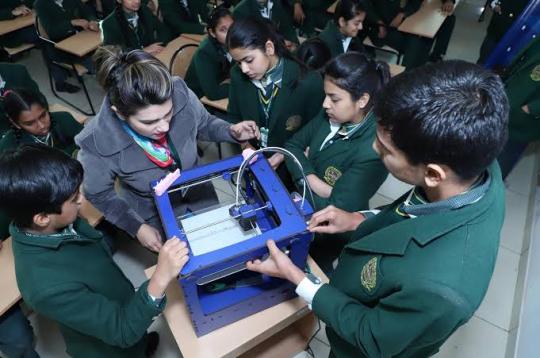
#franchise school model#franchise of english medium school#top 10 high school franchise in india#how to start a cbse school in india#how to start a primary school#satluj world school#franchise opportunities#top franchise business#successful franchise business#best franchise investments#new school franchise#open school business#new upcoming school franchise#private school franchise#World School Franchise#Public School Franchise
0 notes
Text
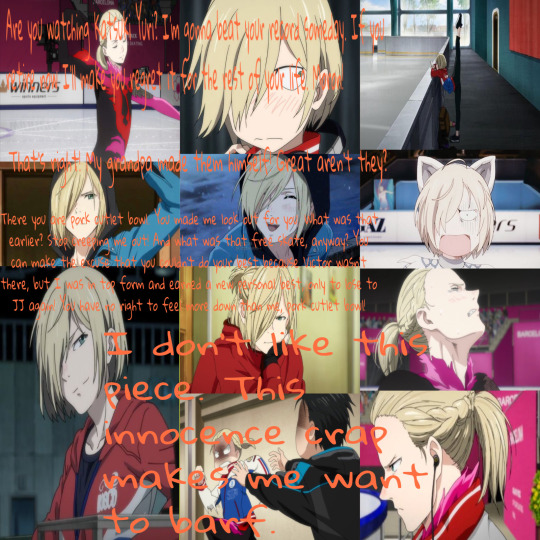
"Are you watching Katsuki Yuri? I'm going to beat your record someday. If you retire now I'll make you regret it for the rest of your life. Moron!
There you are pork cutlet bowl. You made me look for you. What was that earlier? Stop creeping me out! And what was with that free skate anyway? You can make the excuse that you didn't do your best because Victor wasn't there, but I was in top form and earned a new personal best only to lose to JJ again! You have no right to feel more down than me pork cutlet bowl!
I don't like this piece. This innocence crap makes me want to barf." (Yuri "Yurio" Plisetsky, Yuri On Ice.)
It's anime time once again for comfort characters! We are now in my senior year of high school. I was seventeen when a previous best friend of mine came back into my life and told me all about this "gay skating anime" that had recently come out that she was obsessed with. At her recommendation I watched the first episode. That first episode piqued my interest beyond belief and one character in particular I was instantly intrigued by, it's our baby tsun tsun Yurio Plisetsky's time to shine!
Even though at first Yurio was just seen as an angsty kid I knew that there was something special about him. That there was something deeper about his backstory and how that would tie into his character by the very end. And low and behold I was totally right. Yurio is somebody that had to harden his heart and shut the rest of the world out to only focus on one thing. He knew that he had to be the best. If he wasn't the best then he'd let down the one person that has ever stuck around, his grandfather that loves him. This love becomes his driving force for his character development and helps him to open up to his friends. His agape is something that drives his development and character forward.
Yurio's character is actually one of my favorites in all of anime. Part of it is character interactions. Some of his insults just crack me up. Another big chunk of it is his softer moments. My favorite moment in the entire show is when he shares his pork cutlet piroshki's that his grandfather worked hard to make. His smile when he shared them with Yuuri that's the soft shit right there. It was the moment when I knew that he would be my favorite character instead of just "one of" my favorites.
His determination is backed by hard actual talent. He's worked hard to become the best skater of all time in his mind. Even though he might bitch and complain about how hard the practice actually is, like when he had to do ballet, he works his hardest to be incredible at skating. It's why I cheered so loud when I found that he won the big medal at the end of the show instead of Yuuri. I had been rooting for Yurio since day one because I saw that fire and that drive to be the best.

(Only one completely insane cat boi could be this off and it became my favorite skate in the entire franchise. I love Welcome To The Madness and it broke my heart that it wasn't in the official show. His expressions are another thing that I have a soft spot for and I tried to fit as many into this edit as I could.)
Voice actor appreciation time! Oh boy do I have a *lot* of appreciation to discuss with this one because this was one of those that made me reach my hand into the back of my head in shock. In fact, I watched the show three times before I even knew who his VA even was. I was twelve when I went to my local anime con with my parents for the last time. This was the last time that they went with me anyways. My mom was especially excited for this con because the one voice actor that she knows was there, Micah Soulsod. She watched all of Soul Eater with me where he voiced Soul. He is one of those people that is basically a voice puppet. Like he can do anything and play any role that they need for him to. Which is why Yurio Plisetsky surprised me so much. I was watching Anime America's review of the show on Youtube and they were like "Yurio voiced by Micah Soulsod" BITCH SAY WHAT. Ever since then I've given my mad respect to the man who voiced our tiger of Russia in English.
Yurio to me is what welcomed me back to anime. Of course it was by yelling at me but the sentiment was there. It wasn't what officially brought me back into the medium as a whole ( that's tomorrow) but he was done and I kind of had a really bad day so I wasn't in the mood to make another one. I'm going to call my therapist tomorrow and see when I can schedule an appointment. Don't worry though! The daily edits will keep going all throughout this month. It's just that I need to work on my self love a little bit more than I actually do.
#yuri on ice#yurio plisetsky#favorite anime#favorite characters#best tsundere no I will not take your critics keep them to yourself#day 19: yuri on ice
8 notes
·
View notes
Link
Xavierian High School is the Best English Medium School in Bhubaneswar providing quality education to students and influencing and preparing them for their bright future.

Admission in Xavierian High School Bhubaneswar will not be gambling for students as well as their parents. Besides the academics, Xavierian High School also focuses on extracurricular activities of the children. Children are bias-free in comparison of interests, every individual in school, individual refers as students
#best english medium school in bhubaneswar#admission in xaverian high school odisha#top cbse school in Bhubaneswar odisha#franchise of xavierian high school bhubaneswar#xaverian high school
0 notes
Text
My first review of Evangelion: 3.0+1.0 Thrice Upon a Time
Here’s my first impression under the cut...
The franchise as art.
Not just the Eva franchise but the concept of a franchise itself. Because franchises, as they exist in the world of filmmaking, are inherently a capitalist product designed for escapism. Let’s go to the movies for a brand new chapter in the ever-sprawling saga of commoditized characters conquering a new mile in the millennially trotted hero journey, yay! Isn’t that how you can describe the act of purchasing a ticket to the latest entry in your favorite franchise? And what’s so wrong with that, anyway? After all, we need our escapism when life becomes unbearable. It’s just a public service really!
And is Eva really that different? At the end of the day, no matter how avant-garde it can be, it’s still a product that we’ve come to consume, quite literally, again and again. Not only that, but it’s also a damn good profitable IP with millions of merchandise goods, box-office record numbers and, now, a distribution deal with one of the gods of capitalism: Amazon. Long gone are the days of non-profit experiencing of it. You can now legally pay to watch its whole audiovisual canon in Netflix and Prime.
Still, even after its paradoxical commodification, the text of Eva itself remains as a message of anti-escapism. No matter how many figures, blu-rays and streaming services you pay for, the message of Eva remains the same. A message that quite starkly opposes itself to this escapist consumerism. Even if, ironically, is this very message that, due to its humanity, has touched the hearts of millions who have then turned it into another comfort food. This is so sad, alexa play komm, susser tod…
Now, cynicism aside, the reason 3.0+1.0 elevates the concept of a franchise to an art form is, quite simply, because, at its best, art is a method of communication delivering a message that could only be delivered through its chosen medium. I could very easily tell you to go outside and touch some grass, talk to your parents and hug your dearest, but that’d never have the same impact as experiencing the Eva franchise from start to finish.
3.0+1.0 is a film that can’t work without experiencing all the films and TV episodes before it. I mean, it has its own beginning, middle and end but, really, its message can’t be as impactful without the other entries in its franchise. The film itself rehashes images and situations we’ve come to intimately know from its predecessors. Not only that but it converses with them, presenting nuanced and overt contrasts of key moments. Particularly in its final act, we see the reversal and echoes of a lot of moments from End of Evangelion. Asuka gets mangled, not by outside forces, but by her own doing. Misato gets shot but she survives this. Ritsuko shots Gendo, but doesn’t kill him. Shinji doesn’t punish Gendo by devouring him through Unit-01, but instead saves him by getting close to him. This last one might be one of the most heart-wrenching moments in the whole movie, which, it’s worth noting, serves as the wholesome counterpart to EoE’s bitter ending. To say nothing of the contrast 3.0+1.0 presents to EoE’s beach scene…
But these are all narrative points that, with some serious talent, could even be conveyed through literary form and film, as we know, its powerful because its an audiovisual medium. And here’s where Eva, time and again, separates itself from most, if not all, franchises in recent memory. Its images are not only narrative but discursive. I’d even argue that, come its ending, Eva uses images that don’t really advance its plot, but rather help to cement its discourse, its message. And its been doing that since eps 25-26… The last minutes of Eva will always be a Brechtian assault on the senses with images that demand to be studied and interpreted. They’re not there to finish the bedtime story with a kiss on the forehead of your overworked soul, but to shake it out of its zombie state and fill you with emotions you can’t even describe through words until much later, if at all… I believe that’s why a lot of us have come back to Eva again and again. Not necessarily for its plot, but for the rise of emotions and thoughts that bolt through your core as you experience its final moments and how they re-paint the whole journey you’ve just travelled to get there.
3.0+1.0 is filled with such images that, one day, I’d love to analyze. I’m still too shocked from having watched it almost 20 hrs ago and this is already too long, so I’ll leave this task for subsequent viewings… still my mind can’t help but replay certain images over and over, even as I write this… from Misato looking at the photo of her son and Shinji… Kaworu crying as Shinji extends his hand to him… the juxtaposition of Unit-01 lying on its side, staring at the phallic ruins of Nerv HQ, and Shinji, on the same position and equally sized, staring at the piano he played with Kaworu… baby Shinji blatantly rejecting Gendo, only to find comfort with his mom, and baby Asuka painfully looking at this from afar… to the shot of Shinji and Rei, discussing the neon genesis, on an dismantled theater, as frames from the TV anime are projected onto them and the brick wall behind them… I can’t word what these images mean yet, but I’m looking forward to doing it one day…
I suppose this has turned into a long ramble, but I’m still sure of my opening thought. 3.0+1.0 takes elements of every entry on the Evangelion franchise to express a message that could only be conveyed with such impact by having consumed the entire franchise beforehand, and it does so in a way that doesn’t perpetuate the comfortable escapism of other franchises. Its very message of anti-escapism and use of images that converse emotionally, aesthetically, and intellectually with the viewer prevent it from being purely a capitalist product designed for escapism. It’s a piece of art, worth of being discussed at the same level of any work from a grand master of any other type of art. But it’s also a franchise… hopefully this will inspire more franchises as art forms.
And now, as a post-scriptum, because no review of Eva is worth anything without some shameless personal history, I must say that my journey with Eva has been like none other piece of media… I was introduced by it at 18 years old, fresh out of high school, by the person who would become my best friend, and I remember, back then, finding it incredibly comforting and enigmatic. It helped me through a period of drastic change in my life, from changing majors halfway from English to Film, to becoming an older brother at 19 (after a life of being an only child). I was incredibly depressed and struggled with addiction for years after that. I related to Shinji and his perpetual running away from life but, now, seven years later I got to see the conclusion to that journey my best friend invited me to… I also earned my bachelor’s degree in film, have a comfortable job and have been sober for 10 months. I don’t run away as much but I’d be lying if I wasn’t still, somewhat, disconnected from most people in my life. To be honest, I related so much to Gendo’s story on this film and that scared me. It’s still hard to let people in but, still, there’s been some growth. Small victories that allowed me to accept this final film’s message as completely valid. It’s just so wholesome, isn’t it? And yet, there’s a bittersweetness to it… like in every ending, you’re glad it happened but it’s painful coming to terms that it’s over. I cried for a good thirty minutes after it was over, washing the tears away, only to stare at my reflection and turn into a sobbing mess… I’ll never get to experience anything like this for the first time and that’s just incredibly sad… still, I’m so fucking glad for it all, even the wait (as shorter as it was for me) and I do believe I’ll be able to say bye-bye, all of Evangelion… one day.
#evangelion 3.0+1.0#neon genesis evangelion#Shinji Ikari#Kaworu Nagisa#rei ayanami#gendo ikari#Misato Katsuragi
5 notes
·
View notes
Text
OPINION: My Favorite Anime of 2020 Are All Music Videos
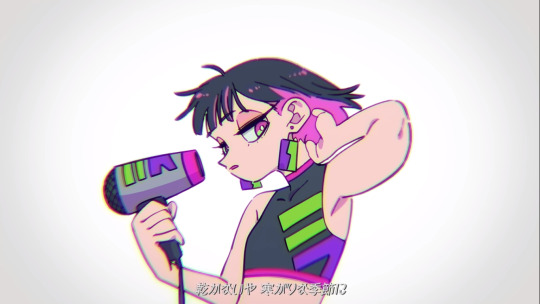
Image via ZUTOMAYO
Despite the enormous pressures of COVID-19, 2020 has had its share of anime classics. Keep Your Hands Off Eizouken! is a stone-cold classic to the degree it now feels as if it’s always existed. Decadence channeled the creative spirit of 2000s-era Madhouse into an off-kilter riff on dystopian science fiction and Pixar movies. Akudama Drive, now in its second half, continues to translate the bonkers, heartfelt pulp style of Danganronpa creator Kazutaka Kodaka to TV anime. There have been big successes in film, as well — Demon Slayer Mugen Train scored the highest opening weekend box office in Japanese history, while folks I follow on Twitter are excited for the new Bones film Josee, the Tiger and the Fish.
One of my favorite anime projects this year was something completely different. It’s "Gotcha!," a short Pokemon-themed music video directed by Rie Matsumoto and her friends at Bones. A sequence that takes all of Matsumoto’s strengths — her attention to detail, the way she depicts exciting and supernatural things bursting out of the walls of our ordinary world, and her obsession with cramming every layer of the screen with stuff — and turns them with the precision of a laser toward celebrating the series’s near 25-year history. As encyclopedic as a Pokedex despite being only three minutes long, it’s a glorious celebration of a series loved and made by passionate fans.
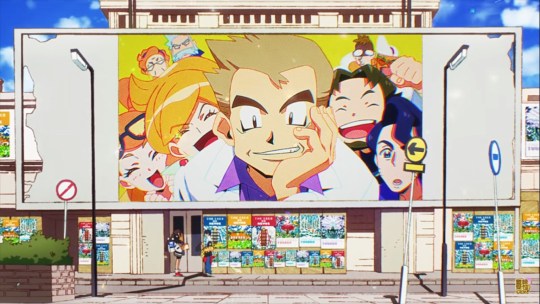
Image via Pokemon Official YouTube Channel
But "Gotcha!" wasn’t even the only fantastic music video made by former employees from the historic studio Toei. Earlier this year, animator Koudai Watanabe collaborated with the talented Naoki Yoshibe — director of the opening sequences for Gatchaman Crowds — to create a music video for ZUTOMAYO titled “STUDY ME.” It’s a rich purple-and-green media landscape of TV screens, glitches, Undertale references, and desperately reaching hands, packed with enough wild ideas and visual iconography to fuel an entire season of anime. But it wraps up in just under five minutes. You’re left watching the video over and over again in a daze, trying in vain to catch every little detail.
The animated music videos being made right now represent the most slept-on creative success in modern anime production among English language fans. (That’s music videos that are animated, not AMVs! You could write an entirely separate article on those.) I need to qualify “slept on,” since hardcore animation nerds like Yuyucow and Catsuka have been stumping for these works over the past several years. There are viral successes like "Gotcha!" and the inevitable crossover that happens when an artist doing the theme song for an anime leads others to check out their back catalog of past videos. But on websites and in magazines, I see stories about Netflix’s aggressive production of new TV series, the renaissance of Japanese anime films after Your Name, and bemused reactions to the shocking popularity of Demon Slayer: Kimetsu no Yaiba. Talk about the newest music videos online is a lot rarer. Not to mention older videos. "Gotcha!" may have broken out as a celebration of a popular game series, but its predecessor — a Lotte chocolate commercial produced by much of the same staff — is just as good!

Image via ZUTOMAYO
"Gotcha!" isn’t 2020’s only spiritual successor to excellent early work, either. In 2013, Yoko Kuno produced the video "Airy Me" as part of a graduate assignment. Set to a song by Cuushe, it’s a hallucinatory epic that’s both starkly horrifying and bittersweet. In the years since, Yoko Kuno’s made a name for herself across several mediums — winning the New Face Award for her manga work at Japan Media Arts Festival, serving as a pinch hitter on Orange’s production of Land of the Lustrous and contributing a memorable sequence to Beastars. She returned this year with filmmaker Tao Tajima to produce another sequence scored to Cuushe’s music, Magic. Riffing on Airy Me's themes of bodily transformation and human ennui, it sets the action against real photographic landscapes. It's another haunting masterwork by one of anime’s most multitalented young artists and has been on repeat for me since it came up on my Twitter feed.

Image via FLAU
Meanwhile, the Japanese vocalist Eve continues to commission new and excellent animated work based on his songs. This May saw the release of "How to Eat Life," a video by indie animator Mariyasu which repurposes Eve’s unique symbology of surly adolescents and freaky puppet monsters into a stylish and spooky carnival of carnivorism. It’s an excellent piece that stands tall among the work collected under Eve’s banner, many of which are stone-cold classics themselves. But "Promise," released at the end of this October, threatens to outdo them all. Directed by Ken Yamamoto and produced at Cloverworks, it plays as another greatest hits compilation of Eve’s works — broken promises, collapsing cityscapes, creatures powered by feeling that shake the earth with their footsteps. There’s a real visceral punch to it that beats out even its excellent predecessors. When the protagonist folds over himself in anguish, you feel it in your gut. When he steps deep into the water and the entire world around him is shredded into pieces, anyone who’s ever been a teenager knows exactly how that feels. When his friend reaches in and pulls him out of that water, that’s real joy rising like bubbles through your veins.

Image via Eve
Ken Yamamoto’s a bit more mainstream than Mariyasu — just last year he contributed some face-melting action sequences to Fate/Grand Order Absolute Demonic Front: Babylonia. But it says something to me that "Promise" — maybe his best work yet — was released as a music video rather than a new TV series. He’s not alone, either. This August, the animator China (storyboarder for Encouragement of Climb’s third season) together with character designer Mooang (storyboarder for Sarazanmai) produced the music video "Sore wo Ai to Yobu dake." Like the reverse of Yamamoto’s "Promise," it’s the story not of a pair of teenage boys and their separation that devastates a cityscape — but of a pair of teenage girls who reach across time to recover the bond they shared in their high school days. A potent combination of FLCL-style faded nostalgia, careful attention to body language, and pure patented kids-falling-through-the-sky-while-frantically-reaching-for-each-other anime magic, it’s one of the best-animated sequences of this year. I’ve linked it to friends just to plead “Watch this thing!” And it ends in less than four minutes long.

Image via Mafumafu
I can’t help but think: Where is China and Moaang’s movie project? Where is Ken Yamamoto’s TV series? Why is it that Rie Matsumoto has produced two excellent music videos over the past two years that commemorate big franchises, but her rumored film project has yet to lift off? Perhaps the truth is that there isn’t room anymore in the TV anime industry for work like this. Many original projects seem to be tied to cellphone games or stage productions. Projects like Decadence are few and far between, and even those that exist play within a space already laid out by past successes. It’s not all bad, of course — Eizouken this year was a great example of an adaptation working in harmony with its source material. And we’ve seen studios like Orange employ weirder anime creators like Yoko Kuno or the stop-motion team dwarf to great effect in their projects. But perhaps animated music videos represent the future for artists like Matsumoto — a medium that pays well, rewards experimentation, and lets strong artists play around without having to dilute their style. A bite-sized format just outside of the soul-draining churn that defines the industry.
Maybe this is fine, though. Short-form work is just as worthy of admiration as long-form work. I’d love feature-length projects from Ken Yamamoto or China, and I’d love for the world to see another Rie Matsumoto story told on a grand scale. But I can’t deny that Matsumoto rocks at putting together fantastic music videos and that I might even prefer the concise flow of "Gotcha!" to her TV series output. Either way, in this historically difficult year, I’m grateful to these folks for turning in career-best work and giving me hope for the future.
Do you have a favorite animated music video? At the risk of getting off track, do you have a favorite anime music video? Do you still watch different fan edits of Hatsune Miku and wowaka's "Rolling Girl" on rotation, like I do? Let me know in the comments!

Adam W is a Features Writer at Crunchyroll. When he isn't rewatching his favorite anime OPs over and over, he sporadically contributes with a loose coalition of friends to a blog called Isn't it Electrifying? You can find him on Twitter at: @wendeego
Do you love writing? Do you love anime? If you have an idea for a features story, pitch it to Crunchyroll Features!
By: Adam Wescott
8 notes
·
View notes
Photo

* 𝐫𝐨𝐜𝐜𝐨 𝐬𝐮𝐥𝐥𝐢𝐯𝐚𝐧 / 𝑶𝑽𝑬𝑹𝑽𝑰𝑬𝑾
all things rocco &&. interactions visage &&. musings graphic ©
B A S I C
NAME: rocco sullivan. NICKNAMES: roc. FACE CLAIM: tyler posey. AGE RANGE: twenty four (24) to thirty one (31). BIRTHDAY: 25 august. SPECIES: human. GENDER: cis man. PRONOUNS: he/him. HOME FANDOM: chicago fire oc. AVAILABILITY: open for plotting. more below, subject to change depending on verse.
F A M I L Y
MOTHER: harley sullivan, nee jackson. FATHER: gregory sullivan. FAMILY: gives you the roots to stand strong and tall. SIBLINGS: rocco is the youngest of eight.
P H Y S I C A L A T T R I B U T E S
RACE/ETHNICITY: mexican, english, scottish, irish, german, distant french. NATIONALITY: american. HEIGHT: five feet and ten inches (5′10) WEIGHT: irrelevant. BUILD: athletic. HAIR: medium. HAIR COLOR: dark brown. EYE COLOR: brown. DOMINANT HAND: right. ANOMALIES: none. SCENT: whatever he got for christmas that year. ACCENT: american. PHYSICAL DISABILITIES: none. LEARNING DISABILITIES: none. ALLERGIES: penecillin. DISORDERS: mild adhd. FASHION: plaid shirts for the most part. NERVOUS TICS: clenched jaw.
L I F E S T Y L E
HOME ADDRESS: varies, verse dependent. RESIDES: varies, verse dependent. BORN: st louis, missouri. RAISED: chicago, illinois. VEHICLE: 2010 lexus rx 350. PHONE: huawei. LAPTOP/COMPUTER: refurbished accer. PETS: none.
HIGH SCHOOL EDUCATION: graduated. COLLEGE EDUCATION: attended some community college classes, didn’t graduate. CAREER: firefighter candidate. EMPLOYER: chicago fire department, can vary depending on verse.
POLITICAL AFFILIATION: independent. RELIGION: presbyterian - attends every now and then with his mother. BELIEFS: depends on who asks. MISDEMEANORS: surprisingly, none. FELONIES: none. TICKETS AND/OR VIOLATIONS: none. DRUGS: none. SMOKES: never. ALCOHOL: only casually - doesn’t drink at home. DIET: is a good cook, spends a lot of time in the kitchen, enjoys it so eats well.
ROMANTIC ORIENTATION: undetermined. SEXUAL ORIENTATION: undetermined. MARTIAL STATUS: varies, verse dependent. CHILDREN: varies, verse dependent. AVAILABILITY: varies, verse dependent. LOOKING FOR: varies, verse dependent.
LANGUAGES: english, spanish.
PHOBIAS: having regrets. HOBBIES: boxing. TRAITS: kind, logical, reliable, aloof, fluffy, skeptical. SOCIAL MEDIA: tweets constantly.
F A V O U R I T E
LOCATION: alberta, canada SPORTS TEAM: calgary flames. GAME: ice hockey. MUSIC: hip hop. SHOWS: breaking bad. MOVIES: the saw movie franchise. FOOD: anything he’s made himself. BEVERAGE: mountain dew. COLOR: black.
C H A R A C T E R
MORAL ALIGNMENT: neutral good. MBTI: esfp. ENNEAGRAM: type 6 - the loyalist. TEMPERAMENT: choleric. WESTERN ZODIAC: virgo. SONG: hot in herre - nelly.
IDEOLOGIES: food is the best way to make yourself feel better.
#&&. rocco sullivan.#&&. rocco sullivan & threads.#&&. rocco sullivan & visage.#&&. rocco sullivan & musings.#&&. stats.
1 note
·
View note
Photo

A few years ago, we met an ESL student (we’ll call him Bryan) who was renowned for his expansive vocabulary. Although he was timid to speak to us at first (he was self-conscious about his accent), once he learned that we shared his favorite avocation, he waxed lyrical about the way he learned difficult and obscure words. During a half-hour conversation, he used the following words with ease: esoteric, visage, avarice, audacity, efficacious, resplendent, litany, paragon, conflagration, and evocation. These words run the gamut of usage and context, but Bryan incorporated them smoothly into his sentences.
Where did this high school student, who openly admitted that he rarely (his euphemism for “never”) reads, encounter these words in the first place?
Bryan was as loath to study vocabulary flash cards as to peruse novels. He didn’t subscribe to a newspaper or a magazine. His friends weren’t prodigies whose parents were renowned lexicographers. He had never even heard of Scrabble.
His secret? He played close to a thousand hours of this popular game:


Yup. No joke.
For those of you who are not familiar with Blizzard Entertainment, it is the game developer responsible for the Starcraft and Warcraft franchises, not to mention the aforementioned Diablo trilogy. These notoriously addictive video games have even led to deaths, so it wasn’t surprising for us to learn that Bryan had “invested” countless hours into slaying rift bosses and mobs of demons. But while he was frantically alternating between left and right clicks on his Logitech G900 Chaos Spectrum, he was also paying attention to the odd names of gear, gems, and skills required to transmogrify (another term he learned through the game) his character into a redoubtable Nephalem.
These are just some of the words he encountered while burning the midnight oil playing the game:

A “conflagration” is a large fire. 🔥

“Esoteric” means ‘intended for or likely to be understood by only a small number of people with a specialized knowledge or interest.’

A “visage” is a person’s face or facial expression. 😚

“Avarice” is a fancy word for ‘greed.’ 🤑
What separates Bryan from hundreds of other people who play countless hours of Diablo III: Reaper of Souls and yet don’t have impressive vocabularies is that he actually takes time out to look up the words he doesn’t know. Don’t get us wrong: he doesn’t literally pause the game in the middle of combat and consult Dictionary.com to find out what “raiment” means. Bryan does that during the countless breaks the game allows, e.g., while examining the legendary loot and gear he won in battle before deciding whether to keep or salvage them. Obviously, 99% of all people who play video games do so exclusively for entertainment, i.e., to have mindless fun. But that doesn’t mean that you can’t learn something while you’re raining a bombardment of burning pitch and stone onto hordes of Cuddle Bears. Having fun and learning aren’t mutually exclusive. Bryan is living proof of that.
At this point, some of you might be thinking “But what if I don’t play video games? Isn’t this article completely irrelevant to me?”
Not so fast. Some of you have probably read our article that similarly praised the usefulness of comic books in improving one’s vocabulary. Had Bryan spent hundreds of hours reading comic books instead of playing Diablo III, the same thing would have happened.
If you don’t play video games or read comic books, you’re still not lost. Do you watch movies or TV shows? Watch your heart out, but turn on the subtitles (even if the program is originally in English); doing so will draw your attention to new words. Here are two words that a Japanese-to-English translator used (from “Tokyo Ghoul”):
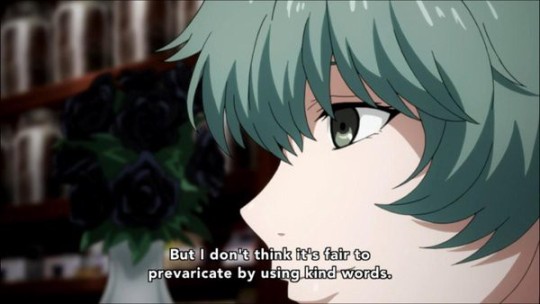
To “prevaricate” is to speak or act in an evasive way to mislead or deceive.
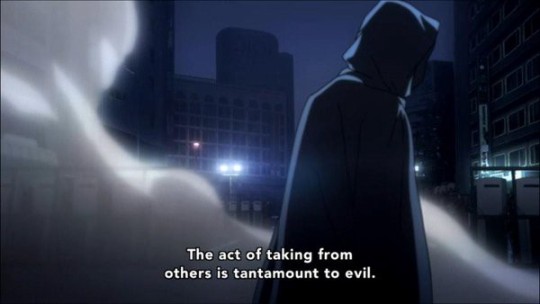
“Tantamount” is a fancy word for ‘same as’ or ‘equal to.’
Do you listen to music? Listen and sing your heart out, but take a look at the lyrics. A band like the Decemberists is renowned for its vocabulary. Even if you’ve never heard of them, you’re probably familiar with Eminem, who CNN reported has one of the largest vocabularies in the music industry. You are bound to encounter a cornucopia of advanced words.
Do you spend a large chunk of time on Twitter? Check what your favorite celebrity has eaten for lunch, but also take a glance at the timeline of accounts such as Dictionary.com, Oxford Dictionaries, Elite Test Prep, and … us! (And if you like archaic words, Haggard Hawks Words has you covered.)
You don’t have to do any extra work, other than the time it requires you to find the word in the dictionary and understand its meaning. But here’s the important part: after you figure out what a word means, use it as often as you can, as soon as you can. That’s easily the best way to learn the word—for life.
By the way, if you love reading 19th-century novels or informative magazines, don’t let anyone tell you that they’re not fun. Because they are. When it comes to expanding your vocabulary while enjoying yourself, you do you.

Website | Twitter | Instagram | Medium | Pinterest | Ko-fi | eBook
#vocabulary#grammar#ELA#EFL#ELT#learn vocabulary#writing#English#English class#learning English#video games#music#comic books#anime
95 notes
·
View notes
Text
Preschool & Playschool Franchise Opportunities
Want a Birla Open Minds School Franchise? Let's connect. Get the right returns on your investment with a school franchise at a low investment. https://birlaopenminds.com/why-birla-open-minds.html
#school franchise#school franchise in india#school franchise business plan#english medium school franchise#best school franchise#best school franchise in india#international school franchise opportunity
0 notes
Text
High School Franchise- Trio Educational Services
Harness the potential of the booming education market in India and become an “Edupreneur” with Trio Educational Services (TES), by setting up a K-12 franchise. Starting a K-12 school is demands upholding the highest of quality standards and strict adherence to rules and regulations. TES has a strong background in creating award winning schools that make a difference to the lives of children, families and the society. TRIO World school is among the most sought-after Indian Curriculum schools in Bengaluru. TRIO can help you setup a school with unparalleled subject diversity and infrastructure, that can cater to a wider pool of students. With the K-12 school market slated to grow at a tremendous pace, TRIO’s globally minded educational approach will help you cater to the needs of students in the upcoming decades.
A TRIO franchise can augment your growth as an entrepreneur by designing a school franchise with you and for you.
TES can advise you on the best possibilities after assessing available infrastructure, resources, and permits. TES will provide end-to-end franchisor support for making crucial decisions about curricula, infrastructure, interiors, marketing, facility planning, recruitment, publicity, business models, publications, professional development and teacher training, quality control and audits.
Trio Educational Services strives to take quality education to students across the world. Our solutions are catered towards involving administration, teachers and parents of students in all our initiatives. We offer franchising opportunities for both ICSE and/or CBSE curricula schools, in both urban areas as well as Tier 2 and Tier 3 cities.
To know more about Trio Educational Franchise, Kindly visit us on https://www.trioeducationalservices.com/k-12-franchisee/
Contact Details:
[email protected] +91 8884470022
Explore more about Trio School Franchise at the below links:
High School Franchise | English Medium School Franchise | Top School Franchise | K-12 Educational Franchise | K-12 School Franchise in Pune | K-12 School Franchise in Kolkata | K-12 School Franchise in Bangalore | K-12 School Franchise in Delhi
#High School Franchise#English Medium School Franchise#Top School Franchise#K-12 Educational Franchise
1 note
·
View note
Text
Breaking Down Comics
A friend of Amanda Donahue, one of my co-creators on THE MARGINS, asked me some questions, and they were so good I felt it was worth dusting off Tumblr to answer. Thanks, Nick, and I hope these rambles give you something worth your while!
Below are Nick’s two questions and my VERY long answers.
Sooo, my first question would just be how you got into it. Is it your primary form of writing?
Great question. So, is it my primary form of writing? Hmmm. I just finished a commitment to a set of 4 interactive mobile game scripts that took up quite a chunk of the last few months. In that time frame I also released a one-shot licensed 22-page comic and a 12-page digital creator-owned comic. So, on balance, I don’t think it’s currently my primary form of writing, but it’s definitely my favorite form, and it’s a medium and industry that I’m both very familiar with and passionate about, so whenever I’m given the chance to write comics, I take it.
However, comics as an industry is a difficult one to navigate. With the two biggest publishers owning incredibly popular franchises, the prime means for writers to make a living on comics is to essentially write super-heroes that you don’t own. And that, in itself, is neither good nor bad. It’s just worth noting that if you want to make comics your primary form of income, then DC and Marvel are going to come into your orbit in some shape. And that type of writing will come with its own set of thrills and challenges.
On the flip side, creator-owned comics and graphic novels can be an extremely fulfilling creative experience, if financially tricky to produce and sell. But the comics industry is still intimate enough that you can find ways to make and sell your comics. There’s a lot more to talk about there with regards to distribution and comics retail, but that’s another conversation.
It’s also worth noting that while the prevailing understanding is that digital comics sell only a fraction of the numbers of printed comics, it’s also a very accessible platform. With time and effort, you can put a comic book out to a global audience.
I may have veered slightly off topic here, but I think the point I’m trying to make is: if you want comics to be your primary form of writing, they most certainly can be. And you can and will make comics passionately and whole-heartedly, and you’ll put them into the world.
But making a living off of them is much more complicated scenario and every creator out there will have different advice for you, but be prepared for an equation that’s pretty familiar to any who has ever freelanced: less control = more money. Generally speaking, of course. There’s always a Walking Dead situation, if all the stars align.
Oh, and I never answered the first part of that question — how did I get into it? I’ll try to bullet point my personal path, which is super wonky, but probably not much stranger than most writers.
It kinda went like this:
Dave’s Writing Career: A Timeline
I always loved comics. In high school, I even wrote and drew 80 pages of a comic that was a horrible pastiche of Marvel/Epic’s Elektra: Assassin by Frank Miller and Bill Sienkiewicz and DC’s The Question by Denny O’Neil, Denys Cowan, and Rick Magyar. However, in my 20s, I’d attend conventions and discover that I had no idea how to move from fandom into professional writing.
I went on to study English and Creative Writing, thinking I’d write prose novels.
Then I moved to LA and fell in with a crowd of Hollywood screenwriter types. I wrote a few screenplays with a writing partner, Jeremy Rogers, but when nothing really came from it, we decided to make our own short films.
We made 3 short films that went into film festivals. At this point, I was tired of spending so much time and money making 10-30 minute films that didn’t result in much. We hatched a new plan: what if we availed ourselves of the iTunes platform and released an audio drama as a podcast?
Wormwood: A Serialized Mystery was the result. It allowed us to tell long, serialized stories, much like my first love: comic books.
Toward the end of the Wormwood run, an illustrator named Jared Souza contacted us. He’d adapted scenes from Wormwood into sequential art, and was curious if we ever thought about turning it into a comic book. We jumped at the chance, and with Jared we wrote and drew an 12-page mini-comic that we printed and took to the San Diego Comic-Con. Hermes Press was interested in our book, and they offered us a deal shortly after the show was over.
From there, I kept thinking about what else I could do with comics. I partnered with Chris Anderson for Lost Angels, and we made another 12-page mini-comic as a sales pitch, and we were offered a digital-first deal with a new publisher, Comicker.
And it keeps going from there, but that is the long and windy road telling stories in a LOT of different formats, each with its own strengths and weaknesses. Learning the strengths of one format does help you to understand the strengths of another. For example, for Wormwood we could really lean into long, twisty passages of monologue because it was all about the actors’ voices. However, as soon as you bring that to comics, you realize the amount of word balloons those monologues would take would utterly cover up any artwork on the page. And so you adjust.
Which is a nice segue to your other question…
Secondly, I'd love to hear how you work things out. As far as layout in regards to story. The most challenging aspect for me is to convert my thinking from imagining in film to now these static images. Do you put a lot of thought into that area, or do you focus mostly on the story and then sort of work that out as you are getting it down?
My initial thought is: “I do both.” But let’s break those up.
In terms of static images: think about the key moments. The perfect still frame of film that sums up the core of a moment of story in your mind. You want to build out from there.
But almost more importantly: think about the gutters. The space between panels. The gutters are actually where all the magic in comics reside. I recommend reading Understanding Comics by Scott McCloud. McCloud is great for understanding how a reader processes the information when we’re as absorbing art in a sequence. And the key is the gutters: The narrative “time” between panels can last a millisecond or a millennium. And the reader understands that from the context. So you’ve got to figure out how much you can get away with in between panels.
A panel exists in one moment in time. One action can occur. Imagine a father and son playing catch. What��s the most important part of that scene? The father throwing? The son catching? That’s two panels. Or, it could be a wide shot of the two, the ball in mid-air, but that wide shot probably should take up as much space on the page as two close angle shots of throwing and catching.
So, you ask yourself: what’s the emotional context of the scene? Is it important to show the father about to throw the ball (perhaps metaphorically teaching his son)? Is it important to show the son catching that ball (perhaps showing the son absorbing the lesson)? Is the activity itself the most important part (the wider shot might work best). It really depends upon the what you want to get out of the scene.
Another example: A man sits in his living room. There’s a knock at the door. He answers. It’s his landlord.
How many panels is that? The only concrete answer I can give you is that it’s ”more than one” — because the of multiple actions involved.
It could be two panels: 1) the man sits reading a newspaper, but his head is cocked because he’s JUST heard the SFX of knocking on his door. 2) he’s standing at the open door and the landlord is asking him for a rent check.
It could be five panels: 1) the main sits reading a newspaper. 2) We show the front door, with knocking SFX. 3) The man opens the door, but we don’t show who it is, building suspense. The man is nervous. 4) we reveal it’s the landlord, standing there, arms crossed and angry. 5) The landlord asks for the rent check.
How important is that scene to your overall story? Five panels is roughly a whole page. Do you want to spend a whole page to show that the man is late with his rent?
That’s brings us to the next part of your question, and the other aspect that’s really important to comics: page count.
Page count is crucial because of the amount of time it takes an artist to draw a page, and also because of the printing costs. A standard issue of a comic is roughly 20-22 pages. So you’ve got to start by knowing how much space you’ve got (some writers will refer to this as “real estate”).
As a general standard, I’m going to assume that you’re looking at a mini-series or story arc that’s probably 5-6 issues, at 20-22 pages per issue. That works for comic book issue publishing, and it collects nicely into a graphic novel.
Even if I know I’m writing a graphic novel (as we did with The Margins), I tend to think in those general terms because it helps me break the story down.
So, I might start by assuming I have 5 chapters that are each 20 pages. Then I figure out — where is the best place to end Chapter One? It shouldn’t just be a moment of pivot — a cliffhanger, something that pushes the reader to start the next chapter as quickly as they can.
I’ll use the film THE MATRIX for this example, but I’m doing this from memory, so this may not be the best story breakdown.
At first thought, knowing I have 5 chapters of 20 pages each, it seems to me a great end to the first chapter might be Neo waking up in his pod in the real world. I mean, you have to read Issue #2 if that’s where Issue #1 ends, right?
If that’s page 20, you now have 19 pages to get there. And you have to get through: Trinity and the agents, Neo following the white rabbit, Neo meeting Trinity, Neo getting a call phone from Morpheus, Neo taken by the agents and getting the tracker put in him. Neo getting the tracker removed. Neo taking the red pill.
That’s a LOT! (It’s probably more than 20 pages, but please bear in my I’m just using this as an example.)
Next I’d think about: how much real estate do I give to Trinity vs. The Agents. Maybe four pages. The first two are the fighting and running across the rooftops. The second two could be a DOUBLE-PAGE SPLASH (two pages that make up one giant image) of Agent Smith ramming his truck into the phone booth. That’d also make for a good title/credits page.
I can probably script that, but I first have to think if I can get though the rest of it with 15 more pages. Ack!
Luckily, the next bits contain a lot of conversations, so we can probably get away with 5-9 panels per page, lots of back and forth conversation, condensed onto fewer pages. And that’s key because we’re going to have to go to larger panels for key action sequences like Neo climbing out on the building ledge. Neo getting the tracker put into his belly.
To be honest, at this point, I’d probably have to rethink some of this — this feels like too much for 20 pages. But hopefully that example shows you how I approach the process. It’s basically taking the whole story and then breaking it into issue-sized chunks, then pages, then finally panels.
And as you think about panels, you do want to make sure you have a mix. Some kind of big splash page is important — it allows you to focus on the biggest moments, and it also gives the reader a bit of a chance to relax, slow down and take in the art. A sequential page can have more panels, but it becomes denser, and each panel can contain less information — one or two dialogue balloons, limited backgrounds, etc. The more panels, the less room and detail each panel can contain.
Personally, I like to think about most of my sequential pages being about 4-8 panels, peppered with one or two splash pages. I can bump up or lower the panel count as needed. If you start by thinking about 3-4 panels for big cinematic action and 5-9 panels for dense conversation or smaller actions, then you’ll probably find yourself with a decent balance through your comic.
Those are my long-winded answers. I hope this helps. There’s much more to talk about in terms of craft, but this covers most of what I think about when breaking down a comic book story.
24 notes
·
View notes
Text
Dragon Ball Super: Future Trunks Arc REVIEW:
(Warning: This review contains spoilers.)
Far from now, in a distant time.** I, Zamasu, immortal lord of the Kai’s, UNLEASHED AN UNSPEAKABLE EVIL! But a foolish Saiyan warrior, wielding a giant sword, step forth to oppose me. Before the final blow was struck he tore open a portal in time, and ran away from the future, where my evil was LAW! Now the fool seeks to return to the past, and undo the future that is Zamasu!
Gotta get back. Back to the past, stop Goku Black. Wa-Watch Out!~
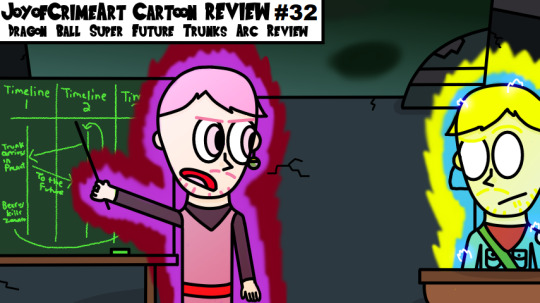
Hello everybody, my name is JoyofCrimeArt, and it’s been…a while since I talked about Dragon Ball Super. Long enough that my plan to review the arcs as the English dub comes out are pretty much dead. But I’m here now, and ready to review the next chapter in the Dragon Ball saga, the “Future Trunks” arc. Which honestly, is a stupid name cause we already had a “Future Trunks” arc. It was called the Android and Cell saga. Why didn’t they just call it the “Goku Black” arc? But whatever. With each arc in Super surpassing that previous one up to this point, will this arc be able to continue the trend? That’s what I’m here find out. Also, given that this arc is a bit longer than the previous ones, I’m going to skim over or abbrev certain things for the sake of time. (Trust me, when we get to the Universe Survival Arc you’ll be glad I’m doing this.) But with all that said, let’s dive in.
The arc begins in Future Trunk’s timeline years after he defeated the androids. And…things are somehow even worse. That’s right, there world has had TWO apocalypses in the span of about thirty years or so. The few remnants of humanity have been forced into hiding as a small resistant stands to fight against this new threat. This resistance, consisting of Future Trunks, Future Bulma, and a future version of Mai of all characters, has one mission in mind. Rebuild the time machine and travel back in time to get help from the past, to help them stop this new enemy. And who is this new enemy? It’s none other than Goku. Or at least, an evil villain impersonating Goku, known as Goku Black. A name that probably sounds a lot better in Japan than it does in a country that has with a sizable black minority, like America.
https://www.youtube.com/watch?v=GDYJO-1IhN8
…Big oof.
But let’s talk about Goku Black for a minute. Now, the idea of making a character that’s designed to be an evil Goku isn’t really anything new. (I mean look at Turles.) However what makes Goku Black, and this whole arc in general, really stand out is the mystery aspect. The whole first half of this arc is all about figuring out who, or what, Goku Black really is and where he came from? And they’re are clues hidden thought that hint towards a larger picture. While Goku Black sounds like Goku, even being played by Sean Schemmel, his cadence is nothing like Goku. His speech is more polite and flowery. Also he refers to Trunks as “mortal” and even “Saiyan” at several points, implying that he is none of those things. It opens questions and allows the audience to speculate. And speaking of voice, Sean Schemmel does an amazing job voicing Black in the dub. Managing to make it sound like Goku while also making it feel distinctly it’s own thing. It’s a really great performance.
Just as Trunks, Mai, and Bulma are about to finish the time machine, Black shows up and attacks. He kills Bulma and injures Mai, but Trunks is just barley able to escape. And while all of this is going on we keep cutting back to wacky hijinks in the present timeline. Things like the Pilaf Gang in school and Goku and Piccolo harvesting lettuces…which really clashes with the incredibly dower tone of what’s going on in Trunk’s timeline. Regardless, Trunk’s time machine arrives in Bulma’s yard. However, they’re not in the clear yet as Goku Black was able to follow them back, briefly, using a magical object known as a time ring.
Goku goes and battles Black. The fight is pretty one sided with Goku holding back, not going beyond Super Saiyan so he can gauge Black’s power and have a good fight. I want you all to remember this, as everything bad that happens in the rest of this arc wouldn’t have happened if Goku had just gone all out on Black from the beginning. After a bit of a brawl Black’s time ring flings him back to the future. But not before he’s able to damage the time machine. Whis notes that the time ring gives the wearers ability to travel between timelines, and are only meant to be worn by Supreme Kais. Not only that but Black’s energy feels remarkably similar to a Supreme Kai in training that exist in universe ten. So with this lead Goku, Whis, and Beerus head off to universe ten, leaving Trunks to explore the present.
When this arc was first announced, I have to admit I wasn’t really looking forward to it. It felt like it was just going to be a rehash of the Android and Cell arcs, with Trunks going back in time to stop another apocalypse. personally, I was fine with the idea of never seeing Future Trunks again, as it felt like his story was over. However, what kinda turned me around on this is all of these neat little interactions that we get to see, which we could only get by having Trunks travel to the “Super” era of the Dragon Ball timeline.
One of these great interactions is between Trunks and Kid Trunks. Kid Trunks forms this almost sibling-esq rivalry with his future self, which is honestly pretty fun to see. And we get the most elaborate two person love triangle ever devised. You see Kid Trunks has a crush on Mai, who’s actually a forty year old woman trapped in a child’s body. (But Kid Trunks doesn’t know this.) Mai, being an adult mentally, has a crush on Future Trunks. Meanwhile, Future Trunks has a thing for Future Mai, who’s is actually a middle aged woman trapped in a young adult body. So…
https://www.youtube.com/watch?v=6SC-KleaUBc
We also get to see interactions like Trunks learning that Krillin married Android 18. As well as Trunks getting to meet adult Gohan. Now keep in mind, the last time Trunks saw Gohan he just unlocked Super Saiyan Two and had just completely decimated Cell. And this is what he sees when he meets him here.

Let me explain why this image is the best scene ever. We got Trunks on the left, representing all the Gohan fans out there. We got Videl being all like _“MAI BAE!” _And then we have Mr. Satan who just looks like he’s completely high on Quaaludes and is just here for the ride.
Meanwhile, Goku arrives in universe ten they meet the universes Supreme Kai, Gowasu, along with his apprentice Zamasu. Zamasu was the former North Kai of universe ten, and is now being trained to take up the role of Supreme Kai when Gowasu eventually dies. Whis senses that Zamasu’s energy feels very similar to Black’s, but they don’t wanna tip there hand just yet. So Goku challenges Zamasu to a friendly fight to see if they’re fighting styles are similar, without telling him about Black. Zamasu is hesitant to battle a mere mortal, but he complies.
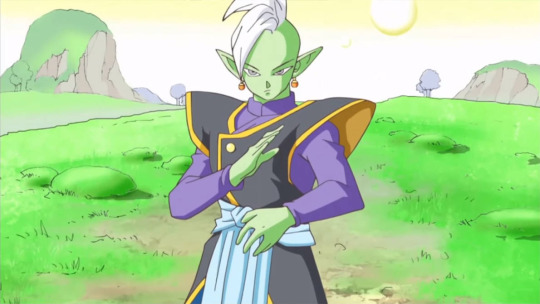
Now let’s talk about Zamasu. I’ll be honest, one of the main reasons for me doing these Dragon Ball Super retrospects in the first place was just so I could have an excuse to talk about/make fun of Zamasu. Zamasu is great, and let me tell you why. Zamasu is very different from other Kai’s in a multitude of ways. Unlike the generally peaceful Kais, Zamasu has a massive disdain for mortals. He believing that they are sinful by nature, and only cause destruction. As such. he also believes that the Kai’s should take on a more hands on approach to running the universe. When you really look at it, He’s not wrong in his assumptions. The Kai’s are pretty useless in general, and it seems like SOMETHING’S always putting the universe in danger every other week or so. So his way of thinking comes from a fairly rational place.
That being said though, it’s pretty clear from the beginning that something isn’t right with Zamasu. While he doesn’t seem outright evil, he definitely doesn’t seem nice either. And given the fact that he is the only suspect in the Goku Black mystery (and the fact that he is featured so prominently in the arcs theme song.) It’s pretty clear that he is involved in one way or whatever. Usually something like this would ruin the mystery, but it actually works here. We know Zamasu is somehow tied in with Goku Black and is probably up to no good, but we don’t know exactly how. The mystery is less about finding out WHO the culprit is is as it is figuring out HOW the culprit is committing the crime, and finding proof. It’s also a refreshing change of paste to have a villain with somewhat noble intentions, at least at the start. Most antagonist in this franchise are just evil from the start for no real reason, but it’s nice seeing a characters decent into darkness. But it’s not the motivation or the mystery that makes me love Zamasu as a character. _I LOVE HIM BECAUSE HE’S SUCH A FRICKIN’ EDGE LORD! AND THE SHOW ACKNOWLEDGES IT! _Zamasu is that emo kid who thinks he knows everything about the world and believes that he is above it all. “Cause he isn’t blinded like the other idiotic mass! He’s deep man!” And it’s just to great!

Zamasu is voiced by James Marster. At first I didn’t really like the voice, as it sounded a lot older than what I was expecting. But it really grew on me as time went on. James Marster has been a massive Dragon Ball fan for much of his life. Even agreeing to play Piccolo in the Dragon Ball Evolution movie. So to see him get a chance to finally be in a piece of Dragon Ball medium that’s actually…good. He does a really stellar job, capturing the pompousness and the insanity of the character really well. His performance is one of the arcs highlights.
Zamasu fights Goku and Goku is able to beat him in his Super Saiyan 2 form. Zamasu is disgusted that he was beaten by a mortal, and silently swears revenge on Goku for besting him. However, Goku isn’t able to make any firm connections between him and Goku Black. So he, Beerus and Whis head back to Earth.
With Trunk’s time machine was destroyed Bulma and the Pilaf gang began working on repairing Cell’s old time machine from all the way back in the Cell saga, which Bulma had kept in capsule form for all these years. As they wait for the time machine to be prepared it allows Trunks and Vegeta to do some good old father-son bonding.

_See everybody, Vegeta’s great at helping people as long as he can do it by punching and threatening them!
_ While all that’s going on Beerus and Whis get a message from none other than the Omni-King himself. And for some reason, he wants to see Goku. The two are obviously worried as Zeno is capable of whipping out entire universe in an instant and Goku…is Goku. But with no real option Goku, Whis, and the Supreme Kai head off to Zeno’s palace to see what he wants. They are greeted by Zeno’s Grand Priest, who Whis confirms is one of the five strongest people in the multiverse. He leads them down to Zeno’s throne room where Zeno tells Goku what he wants. He wants a friend.
The gods are shocked, but really it makes sense. Zeno is just a little kid, and it must get lonely at the top. All the other deities fear the Omni-King due to the sheer amount of destructive power that he possesses. But Goku is the only one who’s ever treated Zeno like an actual person, due to just how kind and thick headed he is. This lack of hesitation has earned him the Omni-Kings respect. Goku tells Zeno that he can’t play with him right now, since he’s a bit preoccupied at the moment. But he says that when he’s done, he’ll find Zeno a friend that’s even better than he is. Zeno agrees and gives Goku a button that can summon him directly once Goku finds this friend. Goku puts this very obvious Checkov’s gun in his pocket for latter and arrives on Earth just as Bulma is finishing the time machine.
Now that it is fixed, Goku, Vegeta, and Trunks hop in the machine to face Black head on. They arrive and find they’re way to the resistance HQ, where Trunks is reunited with the Future Mai. But it doesn’t take long for them to encounter Goku Black, who through a combination of zenkai boost, and getting a better handle on Goku’s body, is much stronger than he was during his first encounter with Goku. He’s even able to transform into his own twisted version of Super Saiyan Blue known as Super Saiyan Rose.
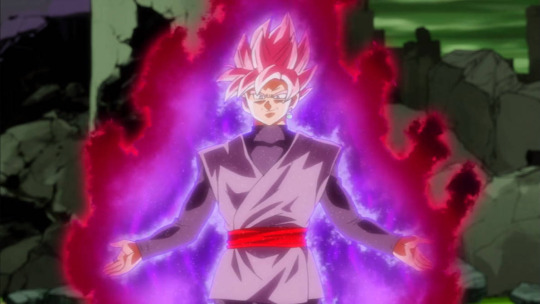

Vegeta, ready to beat up anyone who looks like Goku, attacks Black. And as we know, every time Vegeta fights the arc’s main antagonist, it-it usually goes really well for him, so we shouldn’t have anything to worry about-
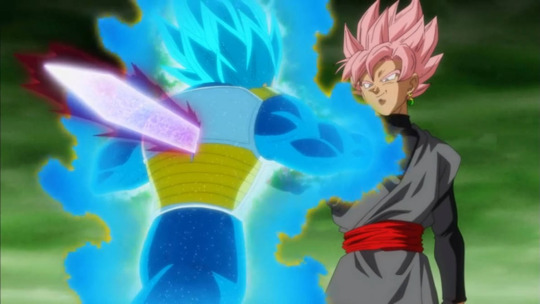
_VEGETA! You’re suppose to learn from your past mistakes! _
And if all that wasn’t bad enough, a time portal opens up in the sky revealing Zamasu. Or at least, a future version of Zamasu with potara and a time ring. That’s right, Zamasu isn’t Black, he’s working with Black. (Or so it seems at least.) The three try to battle the duo in a really well done fight scene, but they notice something about this version of Zamasu. No matter how much damage they inflict on him, he just heals from it seconds after. He’s somehow invincible. This, coupled with Goku Black’s new power, is simply to much for our heroes to handle. Luckily, they’re able to just barley about the escape in the time machine in the nick of time due to Mai distracting Zamasu and Black.
Meanwhile, the present version of Zamasu is becoming more and more fascinated with Goku. Gowasu is as well, and even does some research on him on Godtube. The actual thing that actually exist in this universe and is an important plot point. That’s right, apparently the entire Universe Six tournament was actually live streamed this entire time!. Though I can’t speak to the validity of Godtube as a platform. Heard they’re copyright system is pretty bad.

Dang it, Toei!
Zamasu see’s Super Saiyan Blue Goku’s fight with Hit and is furious that a mortal like Goku is able to achieve such Godly powers. And it’s at this point that you realize that Zamasu is really just the Frank Grimes of the Dragon Ball franchise. And Goku is _Homer. And I’m okay with that…
_But this is where Zamasu learns about the Super Dragon Balls. He goes to Zuno (The all knowing alien from the last arc.) and demands information from him. And this is where Zamasu comes up with his plan. He’ll use the Super Dragon Balls to swap bodies with Goku, than use the time rings to travel to a different timeline, and team up with a parallel version of himself. Then THAT Zamasu will use the Super Dragon Balls in order to wish for immortality. Than they will begin they’re plan to whip out all mortal life from the multiverse. Convoluted enough? But hey, at least unlike other villains he plans on wishing for immortality BEFORE engaging our heroes.

But before he can do this, he needs to kill Gowasu first. As only a Supreme Kai can use the time rings. Goku, Whis, and Beerus begin to figure out this plan. (They figure parts of it out later, but I’m abbreviating this for the sake on length.) They travel to the tenth universe and catch Zamasu in the act of murdering Gowasu, but Whis uses his time rewind powers to save him. It’s honestly a clever and unexpected twist. Seeing the ability again here makes it feel less like it was something only invented to get our heroes out of a jam in the Resurrection ‘F’ arc. Even if it still most likely was.
Beerus, being sick of having nothing to do this arc, destroys Zamasu. They return to Earth to tell Trunks about the good news. Trunks tries to explain that time travel doesn’t work that way in this universe, but Beerus just wants this arc to be over with and buggers off. Trunks, Goku, Vegeta, and even Bulma decide to go to the future and see if everything’s all right. Now, I know what your probably thinking. Shouldn’t they have some kinda plan to fight Zamasu and Black just in case they are still in the future? Or at the very least, do some training first? But, y'know, they’ll probably just cross that bridge when they get to it.
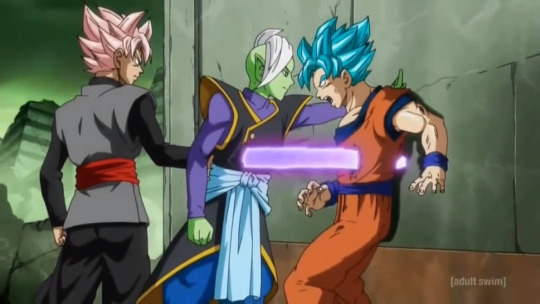
_GOKU! You’re suppose to learn from your past mistakes!
_ Things come to a head when Black and Zamasu point out that all of this has been a self fulfilling paradox. If Trunks never went back in time in the first place, Goku would of never met Zamasu, Zamasu wouldn’t have become Black, and the future wouldn’t of been destroyed. And since I didn’t know where else to point this out, I just wanna praise that that fact that everything that has happened in this art does follow the rules of time traveling that the story established. Given how losey goosey Dragon Ball can be with it’s own lore and consistency, I was sure there would be some kind of plot hole regarding something as elaborate as time travel. But, surprisingly, they went through the effort to keep everything consistent. They forgot what color hair Trunks was suppose to have, but they got this right. So kudos.
Trunks is furious when Zamasu and Black point out that, in a way, this is all his doing. He has a breaking point as the two mock him. And in his anger, he develops a new transformation. Super Saiyan…they never name it in the series proper. I know that it’s called Super Saiyan Anger or Rage or whatever the translation is, but they never name it in the series or explain what exactly it is beyond a form that is formed via anger. _AKA: ALL THE NON GODLY SAIYAN FORMS, CAUSE THEY’RE ALL FUELED BY ANGER! _

That being said though, despite the lack of real explanation on how it works and the fact that it doesn’t really add much to the plot, I have to say it’s one of the coolest looking forms in the series. Like Super Saiyan Blue Kai-o-Ken it has two aura’s, as well as incorporating elements from Buff Super Saiyan form used in the Cell saga. I wish they elaborated on it more, cause this design feel way too cool to be this quote unquote generic.
Trunks holds Black and Zamasu off while the rest of the group travel back in time on more time in order to find a way to actually STOP Zamasu and Black for good. Goku goes to Roshi in order to learn how to do the Evil Containment Wave, in hopes of being about to seal away Zamasu rather than kill him. Meanwhile Vegeta goes to train for twelve hours in the hyperbolic time chamber. They return to the future to have they’re final rematch with Black and Zamasu.
While this is going on Beerus realizes that he’s failed to kill Zamasu and actually feels bad. Not bad enough to go and help, but bad enough to send Gowasu and Shin to help in his place.
They arrive in the time machine, which Black immediately destroys, also damaging the jar they were planning on sealing Zamasu in. See, unlike other villains, Zamasu and Black are actually proactive. I like that. It’s up to Trunks, Mai, and Bulma to fix both the time machine and the jar. Fighting ensues as Vegeta just wails on Black. Black realizes that anger can result in him getting more strength, so he channels that anger into…a scythe…that he uses to open a portal in space time, that creates clones of himself….being angry did this. Ah, whatever, the arc’s almost over. Who cares?

_So, could Vegeta and Goku do this too? I can’t think of any logical reason why they shouldn’t be able to.
_ While Goku and Vegeta are busy with the clones of Black, Zamasu heads for Trunks. The only hope is for Trunks to preform the Evil Containment Wave. Luckily Bulma has a video of it on her phone for Trunks to use as a reference. Bulma goes out to buy him some time by trying to seduce Zamasu in one of the greatest scenes ever put to television, and Trunks is able to successfully preform the move, trapping Zamasu in the jar forever…
Or at least he would of if Goku hadn’t forgot the seal! _TWICE! TWICE GOKU FU*K UP IN STOPPING THE VILLAINS! _Since Zamasu’s free, he realizes that it’s time to take these mortals seriously. So using the potara earrings he fuses with Black, becoming FUSED ZAMASU! Who manages to somehow be even more of an edgelord than he was before!
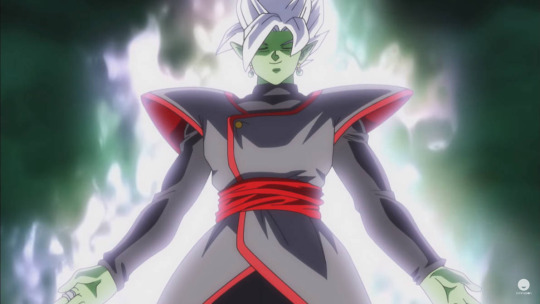
_AND THIS…IS TO GO��EVEN FURTHER…BEYOND! IT’S SUPER SAIYAN EDGE!
_The three of them simply aren’t strong enough to stop Zamasu in this state. They’re only hope is to use the potara themselves and fuse into Vegeto! Which is retconned into only being permanent with Kais. Cause fusions are popular and they’re going to milk it for all it’s worth. Even though they could of had them return to normal without the need for a retcon cause it’s been established that the dragon balls can undo a fusion…but who cares? Now they only stay fused for an hour, but the more energy they use, the shorter amount of time they can be fused. They fuse and go Super Saiyan Blue and we get one of the best fights we’ve had in the series thus far, despite it only being about two minutes. The fluidity of the animation is done in a way that Dragon Ball has never really done up until this point, and resembles a fight from _One Punch Man _more than Dragon Ball.
It’s during this fight that they discover how to beat Zamasu. While Zamasu was immortal Goku Black wasn’t. When Zamasu took Goku’s body he also inherited many of his Saiyan traits, including lust for battle and his desire to have a proper challenge. As such he never wanted immortality and now that he and Zamasu are fused together, he isn’t wholly immortal anymore, and his body begins going into flux. Unfortunately they burn up they’re energy to quickly and defuse before they’re able to kill Zamasu. Unable to even transform anymore due to how depleted they are, it’s up to Trunks to stop him. All the resistance members cheer Trunks on, and they’re hope and belief in him forms into a mini spirit bomb that he channels through his sword. He uses this energy to defeat Zamasu by slicing him in half. Dick first no less.

This ending seemed to be a bit divisive when it first came out, with many people saying it was a Deus ex Machina. And I have to say that I kinda agreed with a lot of the criticism when I first saw it. Trunks learning the Evil Containment Wave so fast via just one video he saw was one thing, but the spirit bomb is literally a move that he never learned. Nor even really had an opportunity to learn. However, while it doesn’t make sense logically, this ending does work really well in a thematic sense. It ties in to the arcs, and even all of Super in general, theme of mortals rising up to reach a power beyond the Gods. It shows that, when all of humanity works together for a common ideal, they is no limit to there power. Cause in the end, humans where able to do what the Gods couldn’t. Beerus’s plan to kill Zamasu failed. Shin and Gowasu’s plan with the potara’s failed. Even Goku and Vegeta’s plan of using God Ki failed. In the end it was all of humanity, giving they’re power to Trunks, they’re one hope, that was able to defeat Zamasu once and for all. And it shows that Trunks was able to save his own future, without needing to rely on Goku and Vegeta or Gohan or anyone else. Zamasu and Black where his problem, and he had to be the one to stop them.
So that was my review of Dragon Ball Super: Future Trunks arc. So what are my final thought…and wait. What do you mean they’re one more episode left?…
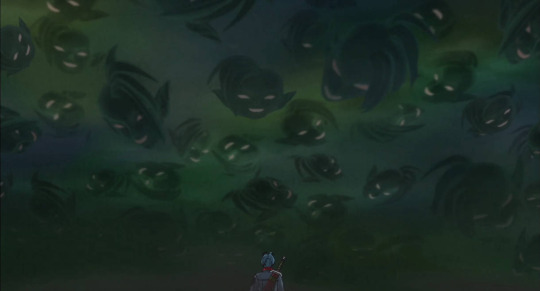
…Oh no…
So Zamasu, being truly immortal, isn’t killed by his body being destroyed. He simply transforms into an ethereal state, in honestly one of the most horrifying things Dragon Ball has ever done. He turns into Gygas from Earthbound and in one attack levels the Earth and whips out all of humanity minus our heroes. Without a body there’s nothing for our heroes to fight, and all hope seems loss. Until Goku remembers Zeno’s button and calls him for help. This summons the Future Zeno, which is weird cause you’d think God would be like beyond the confines of space and time, but apparently he isn’t. Zeno see’s all the damage Zamasu has done and decides to deal with this by destroying the timeline completely. The gang escape in they’re time machine before being erased too. You know, I was joking around with the Samurai Jack comparisons at the beginning, but that’s basically what ends up happening. Goku returns to the void that was once Trunks timeline and grabs the Future Zeno and brings him to the present. He goes to present Zeno and tells him that he’s found his new friend. We also learn that the Grand Priest is Whis’s dad.
After returning to Earth, our heroes discuss what to do now. Whis mentions that when Beerus killed the present Zamaus it created a new time ring, and that Trunks and Mai could use that to travel to a new future. One that never had Zamasu in it. That’s right, they’re taking the Rick and Morty approach. “Close enough, right?” They fly off in the time machine together and then the arc ends.
Now, I will say this. Having the guts to have an arc like this end on such a bittersweet note is definitely a ballsy move. In a world where so many problems can be solved by just collecting the Dragon Balls, I like the idea of their actually being serious consequences that can’t be fixed. But because this all happens in the last episode of the arc, there’s no time to let this sink in. And the ending is just to depressing. The arc basically ends on-
https://www.youtube.com/watch?v=0Ufmrn7BCuA
Everyone in Trunks timeline is dead. Not just dead but erased from existence completely. Trunks failed to save his future, making not just this whole arc pointless, but the Android and Cell saga pointless too! Why even go to a new timeline at all? Why not stay in the present timeline? At least you know these people! Everything Trunks said about the power of humanity working together was wrong. Humans couldn’t stop Zamasu. They needed the power of a God to save them. And the entire DESTRUCTION of an entire timeline could of been avoided if Goku hadn’t summoned Zeno. Or if he had just brought the dang seal. Or, you know, if he defeated Black in their first fight!
So yeah, in conclusion, I feel very mixed on this arc. There are a lot of pros. Zamasu and Black are both fantastic villains who in my opinion deserve more recognition. Also it’s refreshing just to have a new Dragon Ball villain, as appose to all the other arc antagonist who are rivals or…Frieza again. I appreciate the darker tone and the feeling of actual stakes, which is something the last two arcs felt particularly lacking in. And I also enjoy all the fun moments we get seeing Trunks interact with the older Z fighters. But man, does the ending kill a lot of what the arc had going for it. Also the arc drags a bit in parts, as personally I feel you could cut out at least one of the trips to the future. Overall, I think I’d say the arc is still the best arc the series has had so far, but it’s defiantly a case of higher highs and lower lows. But at least we don’t have any evil Goku’s to worry about.
Cause the one we have is enough trouble as it is.
So that was my review of the “Future Trunks” arc of Dragon Ball Super. What did you think? Feel free to leave any thoughts you have in the comments down bellow. I’d love to hear them. Fav, follow, and like the review if you’d enjoy and have a great day.
(I do not own any of the images or videos in this review. All credit goes to there original owners.)
https://www.deviantart.com/joyofcrimeart/journal/Dragon-Ball-Super-Future-Trunks-Arc-REVIEW-793870861 DA Link
5 notes
·
View notes
Text
5 Best Play Schools in India for the best education
Introduction
The Indian education system is one of the best in the world and boasts of producing some of the brightest minds. However, there are times when it becomes difficult for parents to choose a good school for their children. There are many factors that can affect your decision to enroll your child in a particular institution and one such factor is its location. If you live in Mumbai or Delhi, getting admission to a reputed play school will not be an issue but if you live in smaller cities like Jaipur or Trivandrum then things might get complicated. This article will help you find top 5 play schools in India based on popularity and ratings on Google Maps!
Drs Kids

Drs Kids is a play school in India that provides a unique learning environment for kids. The school has been rated as the best play schools in India by many parents and teachers. The school has a well-structured curriculum that helps kids learn and grow at their own pace. In addition to this, Drs Kids also provides complimentary meals to all of its students which makes it more affordable to send your child there.
The school focuses on providing children with an enriching experience through fun educational activities that help develop their creativity, communication skills, motor skills and critical thinking ability. They offer classes from Pre Nursery till Standard 6th grade (Class 10).
Eurokids India
Eurokids India is a chain of play schools in India. It was founded by the French entrepreneur, Jean-Marc De Boni. The first Eurokids school was opened in France in 1987, and Eurokids International has grown to be an international franchise with over 100 schools across Europe and Asia.
The first franchisee for Eurokids India was Bhavna Bhatia who opened a branch in Mumbai’s Andheri suburb on 1st October 2007. She currently runs three other branches at Bandra (Mumbai), Juhu (Mumbai) and Powai (Mumbai).
Kidzee
Kidzee is one of the best play schools in India because it offers a wide range of activities to help kids learn and develop. The play school also has a carefully thought out curriculum, which includes various kinds of learning and development activities that are meant to be fun for kids.
Kidzee is known as the best play schools in India because it helps children learn while they are having fun. When they enter this institution, they become part of an environment that promotes their growth through various kinds of interactive games and activities which can help them develop physically, emotionally and mentally.
Kangaroo Kids International
Kangaroo Kids International is one of the best play schools in India. Established over 30 years ago, Kangaroo Kids International has branches in different cities across India, including Mumbai, Delhi and Bangalore. The school provides an enriching learning environment for children aged 3 to 12 years old.
The curriculum at Kangaroo Kids International is designed by experts to help children develop their skills in a fun way and give them a great start on their journey towards success at school. Students are taught all the important aspects of education such as Maths, English, Science and Social Studies but also have time to play games with friends or spend time outside exploring nature which helps them develop physically as well as mentally.
Bachpan A Play School
Bachpan A Play School is a well known play school in Delhi which offers high-quality education to its students.
The campus of Bachpan A Play School is spread across an area of 15,000 sq. ft.
Facilities provided at the school include outdoor games like football and cricket, indoor games like carroms etc., music room with instruments like xylophones, drum sets etc., science lab for exploring science through experiments and much more!
The curriculum followed at Bachpan A Play School is based on the National Curriculum Framework (NCF). Students are taught English as a second language along with Hindi medium education starting from Nursery to Class V standard by trained teachers who make learning interesting by using different tools such as songs, dance lessons etc. The aim behind teaching them these two languages is not only to enable them speak fluently but also enable them speak confidently when they grow up so that they do not face any difficulty in communicating with others around them or even when meeting people from other countries who don’t know any Indian language except English or Hindi
Getting your child admission to the right school can contribute greatly to his/her development.
At the end of the day, getting your child admission to the right school can contribute greatly to his/her development. There are several schools that focus on child development and language skills, math and science, sports and physical education as well as art and music.
Conclusion
We hope the list of schools, we have given below, will help you to make the right decision for your child.
0 notes
Text
How to get a school franchise in India?

Education is a sector that has gained its due importance over time. Parents now like to invest in the quality of the education of their child. Rather than only saving money for the future, it is a good way to let your child learn and be a great professional someday soon. So with the demand for more and more good schools, the franchise business is spreading. There are franchises of many reputed schools now in places other than their original branch. Parents look for the Best School Franchise In India, close to their home. This allows the child to learn in the vicinity of the home and not stay in a hostel.
What are the facilities in a franchise school?
The quality and standard of the franchise school are maintained the same as the main school. The curriculum followed, the timetable and the books all are the same. The faculty is well qualified and experienced, with all the latest technology in their labs for the children. The safety of the students has been kept as a priority. There is a lesser child to teacher ratio. So the students can get better attention from the teachers there are innovation-based studies. The best franchiseschool in India like to give hands-on experience to your child. Children learn better by doing things on their own. There is no rote learning. The environment is full of encouragement and a positive spirit. The children are respected for their uniqueness. Their skills are polished and language vocabulary is enhanced.
Who can get a school franchise?
If there is ample open space to make a playground for the children the school can apply. The building must be student-friendly and colourful furniture. The rooms must be well light and ventilated. The room size must be large. also, there must be no hazardous factories around. The building must have a scope for any upgradation that may be needed. The Best School Franchise In India will need the school to have the latest technology labs for all subjects. The transport must also have air conditioners. Teachers must be well qualified and the ratio of student to teacher has to be less. So, more number of teachers is required.
Make the best of a school franchise opportunity
Being educated is the right of every child. But getting educated from a good school is an opportunity fetched by many. With the increase in income of the people, in general, has also increased the demand for such good schools. All premier schools can not open up branches in different schools. But they can enhance their spread by giving out franchises. The passionate entrepreneurs who are looking forward to making it large in the field of education must try for a CBSE school franchise opportunity. It will lend a helping hand to the base formation of a strong nation. The children are our future, so nurture it right.
Why are schools giving out franchises?
To reach more and more children and improve their future. Quality and standard of education will be enhanced overall. Better options will be available for children who can afford private schooling. The local schools will get affiliation from premium schools and they can upgrade their curriculum and labs. With times more and more teachers are required, so giving out franchises solves this problem. The existing faculty can be employed and their experience is utilized for better growth of kids. The environment of studies is innovation-based and not just theoretical. Kids can have experiential learning and the latest technology to learn. Cocurricular activities are woven into academic learning to give overall development.
Are people looking for a CBSE school franchise opportunity for their kids?
The people do not like to choose a state board for their kids when they can afford private schooling. This will allow the child to have a vast range of studies. Also, the medium of learning is English, which will allow the child to go for further studies anywhere in the world. When children step out to foreign countries, they have had an upper hand at vocabulary. CBSE School Franchise Opportunity is the best for polishing the skills of a child. While it ensures that the individuality of a child is not disturbed. They are given the freedom to express their interests and learn accordingly. Alumni of such schools are now renowned professionals all over the world as doctors, engineers, politicians, artists and more.
0 notes
Text
OPINION: The Life and Times of an Indian Otaku
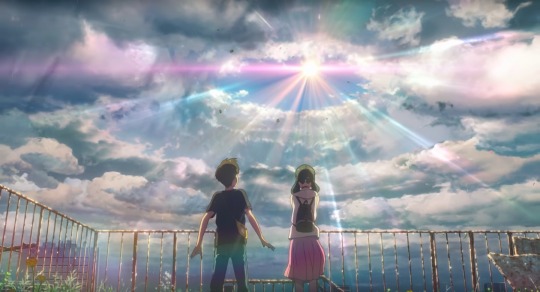
Makoto Shinkai's Weathering With You marked a historic first in my anime watching career. Contrary to popular belief, being the first anime to be released in Indian theaters is not the historic first in question (that honor goes to Shinchan: Bungle in the Jungle). Rather, Weathering With You would become the first film I'd ever watch on opening day — "first day first show" as we Indians call it. In the mad scramble to get tickets, I'd emerged a winner. Was it worth the struggle?
An emphatic yes. It was so good I went on to rewatch it twice.
To fans in India: I’m so happy to tell that ‘Weathering With You’ (Tenki no ko) will release in India this October! We have licensed the Indian distribution rights to PVR Pictures and BookMyShow backed company Vkaao.
— 新海誠 (@shinkaimakoto) August 10, 2019
The Indian theatrical release of Weathering With You in 2019 marked an important moment in the history of the Indian anime fandom. The story of how Shinkai noticed (and fulfilled) an online petition by Indian fans asking for its release here is already the stuff of legend. Because access to anime (especially in theaters) was so scarce in India, even in 2019, fans sought to have the film legally released in theaters. And thanks to Shinkai, it worked. To Indian anime fans, this represented the moment Japan — and the rest of the world — recognized our existence in the fandom. But Indian otakus didn't spring up overnight. Anime has had nearly three decades of history here. It just looks a little different than the rest of the world. The origins of anime in India go back to the '90s. Prior to the economic reforms of 1991, we had one — yes, only one — TV channel, the state-owned Doordarshan. The post-1991 wave of private TV channels brought with it a flood of international TV shows, among them anime like Robotech (which aired on the newly-created Star Plus). Ramayana: The Legend of Prince Rama, the anime adaptation of the Indian mythological epic of the same name, was released in 1992 and had a long and troubled production history, but the end product was a grand success, with its all-star Hindi cast and catchy songs turning it into a TV fixture for well over a decade. It even received a US release, with Bryan Cranston voicing the lead role. The remainder of the '90s would see various anime achieve varying degrees of success, from Nippon Animation's 1989 adaptation of The Jungle Book — which became a nationwide hit — airing in India starting in 1993, to late-night anime like You're Under Arrest and Gunsmith Cats. Despite this, there wasn't yet an actual fandom surrounding anime at the time. That would all change upon the turn of the century.

Cartoon Network revolutionized the Indian anime market when the channel arrived in 2001. The launch of dedicated anime programming block Toonami brought with it two anime that would permanently shape the future of the fandom: Dragon Ball Z and Cardcaptor Sakura (albeit in its heavily-edited Cardcaptors form). While I never watched Dragon Ball Z (compared to all my friends at school), I did watch some Cardcaptors with my sister, which would actually be the very first anime I watched. My own viewing habits notwithstanding, DBZ was very much the anime of the moment. Schoolkids would frequently shout out famous lines from the iconic English dub. We'd even invented various hand games based on attacks and moves from DBZ. In 2003, another monumental shift would come as the childhood classic Pokémon hit the small screen, followed closely by Digimon, Yu-Gi-Oh!, and Beyblade. The merchandise associated with these franchises turned them into smash hits with a younger audience. All the cool kids had Pokemon cards and Beyblade tops. Battling with them at school was the stuff childhood was made of. To this day, these toys continue to sell well. Beyblade tournaments are still very much a thing. While many of my schoolmates were avid fans of DBZ, there were other trends in anime that could be observed, trends that had to do with language. From my experience, certain anime were only available dubbed in Hindi — a language spoken largely by the northern half of the country. Coming from a south Indian city with a significant north Indian population, I could observe a clear trend wherein Hindi-speaking north Indians grew up with these Hindi-dubbed anime, while people in the south (who spoke other languages) largely grew up with titles that were available in English (or Tamil, as fans of DBZ's Tamil dub can testify). Interestingly, these Hindi dubbed anime tended to be ones that were popular in Japan but not so much in the West — stuff like Doraemon, Shin-Chan, KochiKame, and Case Closed. This gave the north Indian anime scene a rather unique flavor. An even more interesting case is that of India's northeastern region (comprised of states like Nagaland, Manipur, and Meghalaya). Being culturally different from the rest of India, these states have had a history of consuming Korean and Japanese media, and they embraced anime and manga in a way the rest of the nation had not. Anime-related cosplay is huge in the northeast, with some of the best cosplay conventions in the nation taking place there and becoming a part of the local fashion scene. The general acceptance of otaku culture in the region continues to be high.
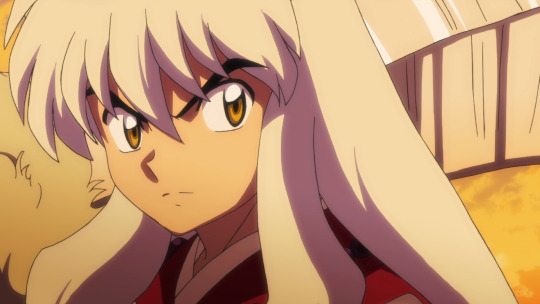
Eventually, anime would become a little more accessible to all. The launch of dedicated channel Animax in 2004 represented another watershed moment in the fandom. The shows Animax brought over were unlike anything we'd seen in the medium. Shows like Bleach, Fullmetal Alchemist: Brotherhood, Inuyasha, and K-On! redefined what anime meant for Indian audiences who had previously seen anime as a childhood interest and no different from other cartoons. As the channel slowly began to shift its focus to the older teen/young adult demographic, more mature anime like Cowboy Bebop, Hell Girl, Akira, and Welcome to the NHK challenged our conservative notions of what was acceptable to air on TV, especially considering these shows aired in daytime slots rather than late-night. This honeymoon period did not last. Animax was delisted by service providers in 2012. The years to come would be some of the most frustrating for us anime fans, as availability was at its most inconsistent and uncertain. While the channel attempted to make a comeback later on in 2016, it eventually disappeared for good in 2017. Despite all these problems, I look back on Animax fondly. Thanks to it, we became aware of the existence of the entity known as "anime." We began to actively seek out anime over other forms of animation. In short, it resulted in the formation of an actual fandom centered around anime. Anime fan clubs began to pop up in major cities like Mumbai, Delhi, Bangalore, and Kolkata. Widespread conventions outside of the northeast region came next. Anime Con India was started in 2010, followed closely by Delhi Comic-Con in 2011. Anime conventions in India are a curious thing. They are very unlike the sprawling, sophisticated conventions of the West. The funds simply aren't there for that sort of thing. I don't recall a single Indian anime convention that was attended by a voice actor, animator, or the like. So what are Indian cons about? In an interview with The Citizen, Anime Con India founder Nitesh Rohit talked about his reason for starting the con: "like any other belief and faith they all needed a temple to congregate (at)." This statement really resonates with me, and sums up what Indian cons are about. What they lack in scale and facilities, they make up for in intimacy and a feeling of togetherness. They are more or less small-scale events for anime fans to find other fans, to network with them, and basically feel less alone. Because feeling alone was part of the original Indian otaku experience. The early fandom was largely an urban phenomenon, as going to cons wasn't an option for everyone and the internet wasn't what it is today. So, you had these disconnected pockets of fans. People around you were unlikely to share your interest in anime and may have even judged you for it. The general consensus in India was (and still is) that animation is a medium for children. And remember, for a long time, anime accessibility varied by region. So, if you were lucky enough to find a kindred otaku, there was no guarantee they were into (or had even heard of) the same titles as you. This meant that we hadn't really had the ability to develop any sort of unique culture or traditions of our own. Things like going to cons, renting anime DVDs, memes and in-jokes — these things didn't exist for the vast majority of early fans who were school-going kids or college students of little means. A culture of our own wouldn't arise until much later — when that generation grew up.
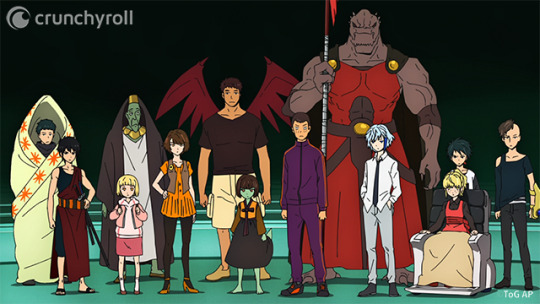
Of course, it wasn't just us who grew up — technology did, too. The internet became more ubiquitous. Social media and forums enabled us to network with each other regardless of location, in ways we'd never have imagined. To the scattered fandom of the early days, this has been nothing short of a blessing. The other big change ushered in by the internet was the era of streaming. Until then, most of our anime viewing took place on television and as previously stated, was not always very consistent. Accessibility improved greatly with the launch of Netflix in 2016. In today's India, Netflix is a household name, with a significant portion of young adults having access to a subscription. With a catalog of over 200 anime, Netflix has been responsible for pulling in many new fans. Plenty of people "come for the movies, stay for the anime." Series like My Hero Academia, Death Note, and One-Punch Man have become mainstream successes in this fashion, with a significant following even among non-anime fans. Another streaming service that is beginning to make inroads into the Indian market is Crunchyroll, with simulcasts like Boruto and originals like Tower of God, and the fact that it is free makes it accessible to anyone with an internet connection. Most Indian anime fans I know of have heard of Crunchyroll, and as more titles get licensed it is inevitable that its popularity will rise. And us otakus are doing plenty to help it do just that.
The success of Weathering With You is a shining example of the tight-knit nature of the Indian anime fandom. All it took was one person (an anime fan named Divishth Pancholi) to create a Change.org petition asking for its release in Indian theaters. The petition went viral, getting over 50,000 signatures and attracting the attention of Shinkai and the producers, resulting in its release here. Today, that event is seen as a smaller part of a greater Indian anime movement that is pushing for increased availability and acceptance of anime in India. Hashtags like #IndiaWantsAnime frequently make their presence felt on social media. This fandom isn't without its problems — it isn't the most inclusive when it comes to non-male fans, the "animation is for kids" specter hasn't been fully shaken off, and I'd love for anime BluRays/DVDs to be more widely available here. But I am grateful for the fandom's existence for getting me into anime in the first place. Without them, I'd have never been sitting in a movie theater on October 11, 2019, watching Weathering With You.
2 notes
·
View notes